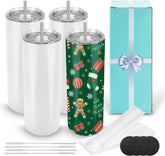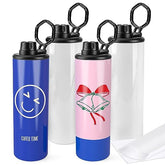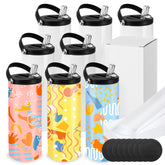How does the sublimation process work on glass drinkware?
Sublimation on glass drinkware involves transferring a design from sublimation paper onto the glass surface using heat and pressure. Here's a step-by-step overview of the process:
1. Design Preparation
-
Create or select a design using graphic design software.
-
Print the design onto sublimation paper using a sublimation printer and sublimation inks. The design should be mirrored (flipped horizontally) before printing.
2. Preparation of Glass Drinkware
-
Ensure the glass surface is clean and free of dust, oils, or residues. Use isopropyl alcohol or a glass cleaner for this purpose.
-
Apply a sublimation coating to the glass if it is not already pre-coated. This coating allows the sublimation ink to bond to the glass surface.
3. Transfer Process
-
Wrap the printed sublimation paper around the glass or place it on the desired area, ensuring the design is in the correct position.
-
Secure the paper with heat-resistant tape to prevent shifting during the transfer.
4. Heat Press Application
-
Use a heat press or a specialized sublimation oven designed for curved surfaces like drinkware.
-
Set the heat press to the appropriate temperature (typically around 380°F or 193°C) and time (usually 60-180 seconds, depending on the equipment and design).
-
Apply even pressure to ensure the design transfers uniformly onto the glass.
5. Cooling and Finishing
-
After the transfer is complete, carefully remove the glass from the heat press and allow it to cool.
-
Peel off the sublimation paper to reveal the design.
-
Inspect the design for quality and durability.
Key Considerations:
-
Sublimation Coating: Plain glass cannot sublimate without a special coating that allows the ink to bond.
-
Temperature and Time: Proper settings are crucial to avoid burning the design or under-transferring.
-
Curved Surfaces: For curved drinkware, a heat press with a curved attachment or a wrap-style press is necessary to ensure even contact.
This process creates vibrant, durable designs that are resistant to fading and washing, making it ideal for custom glass drinkware like mugs, cups, and bottles.









Leave a comment
Please note, comments need to be approved before they are published.